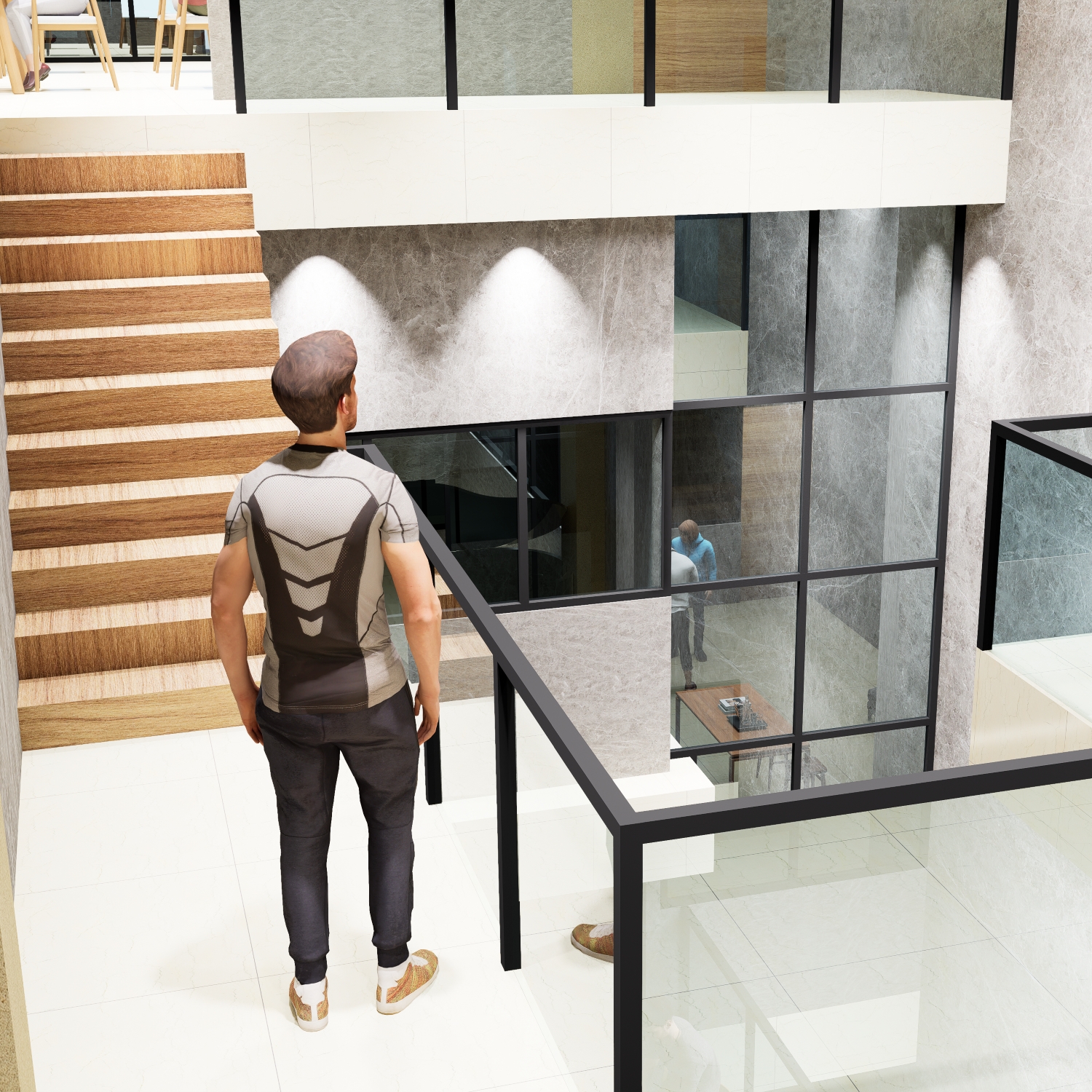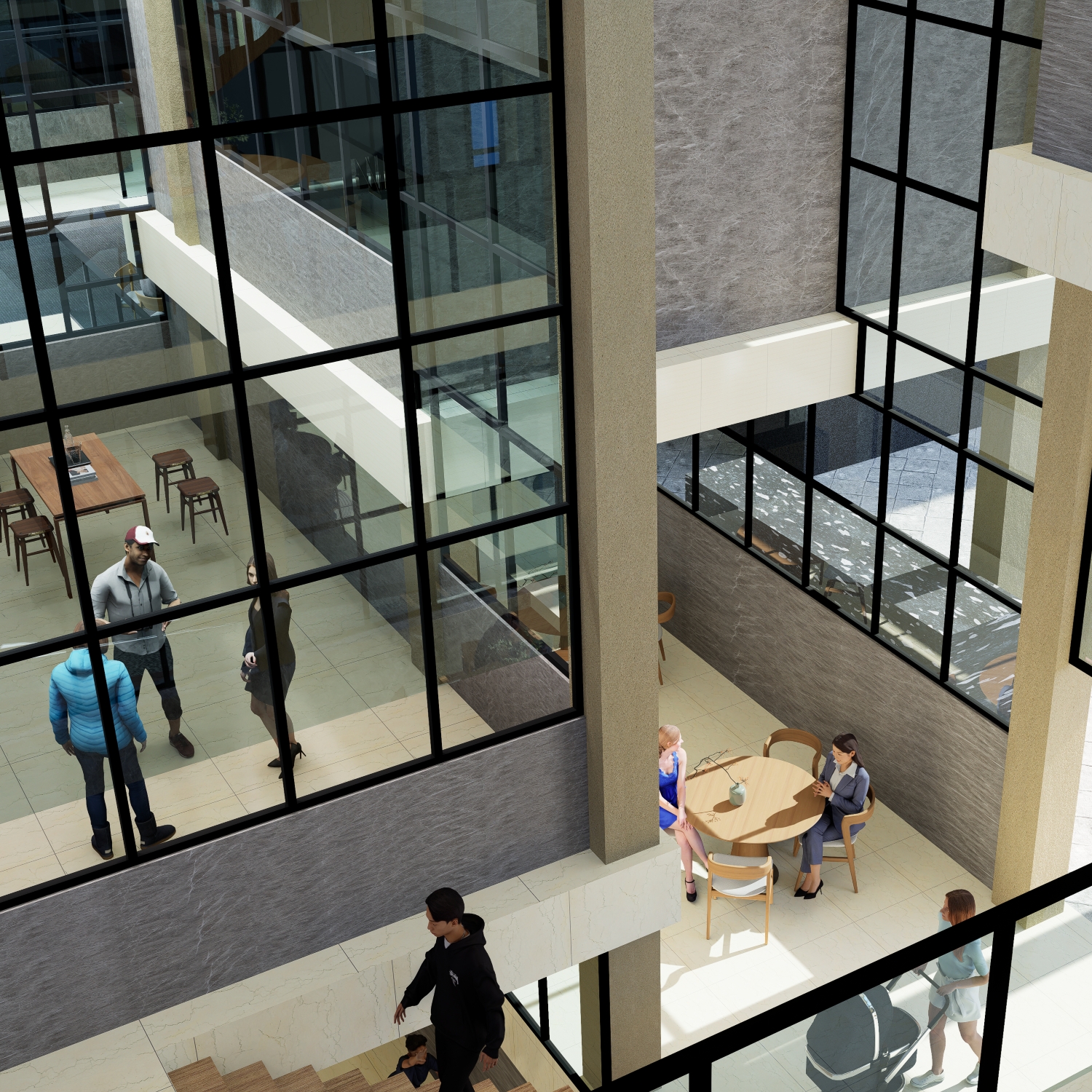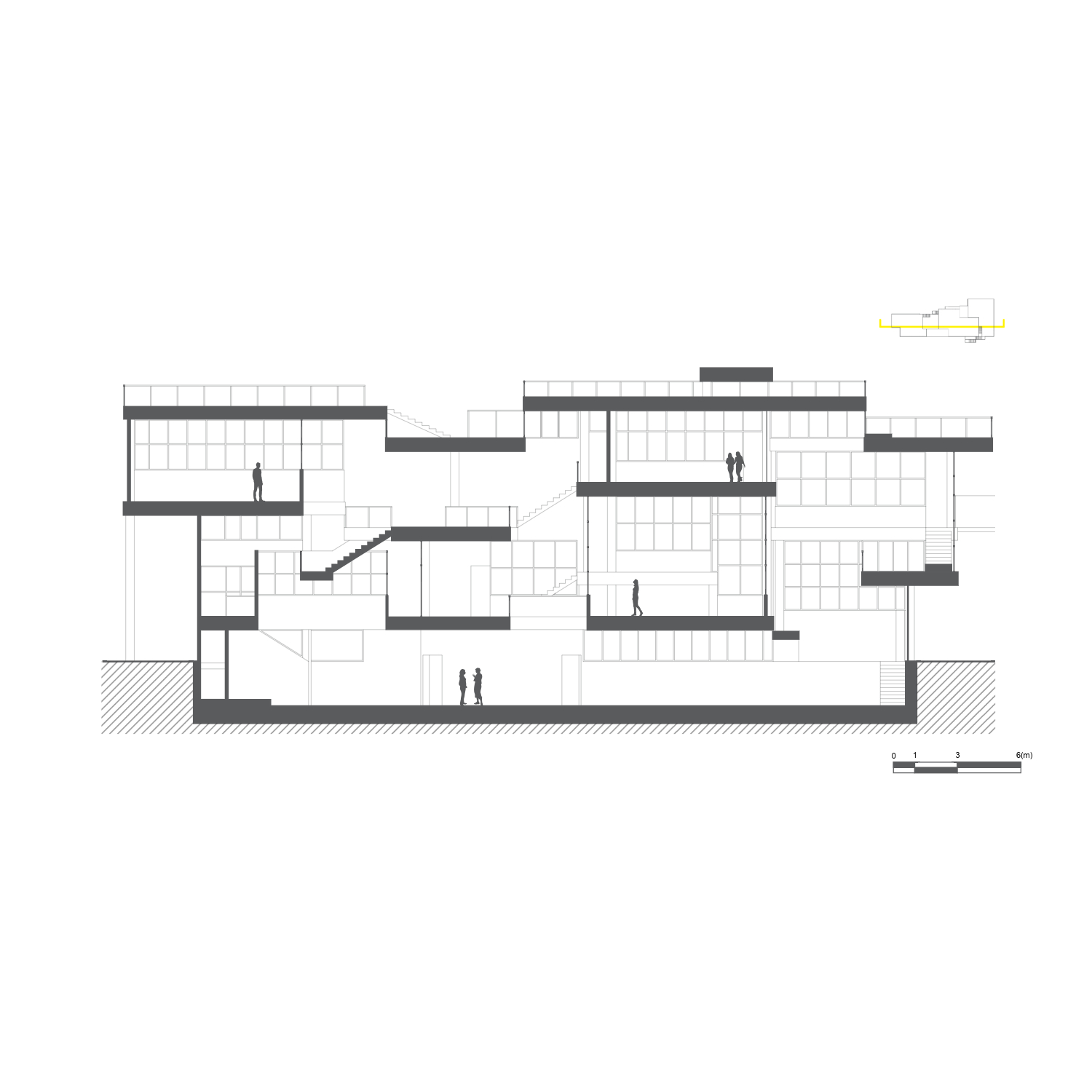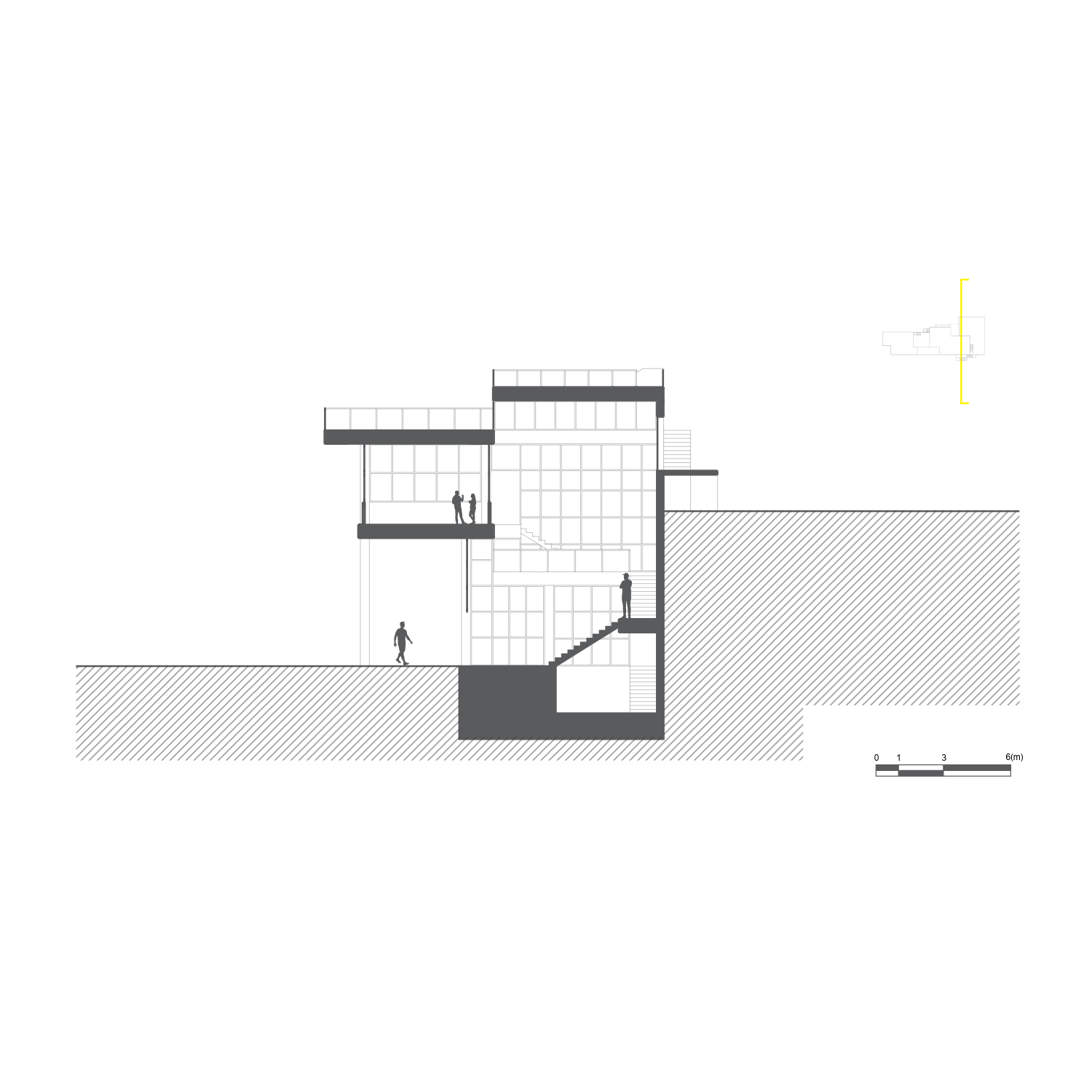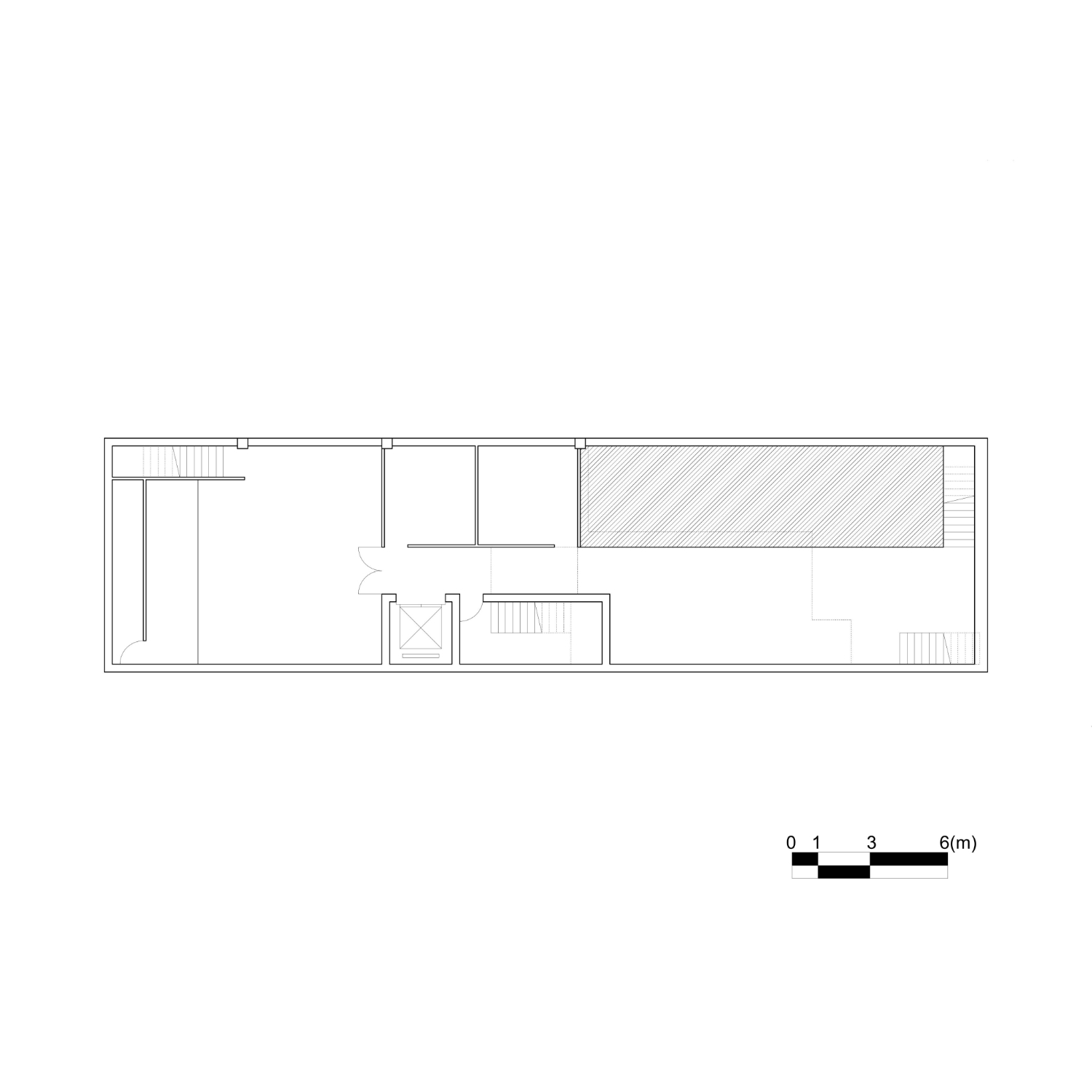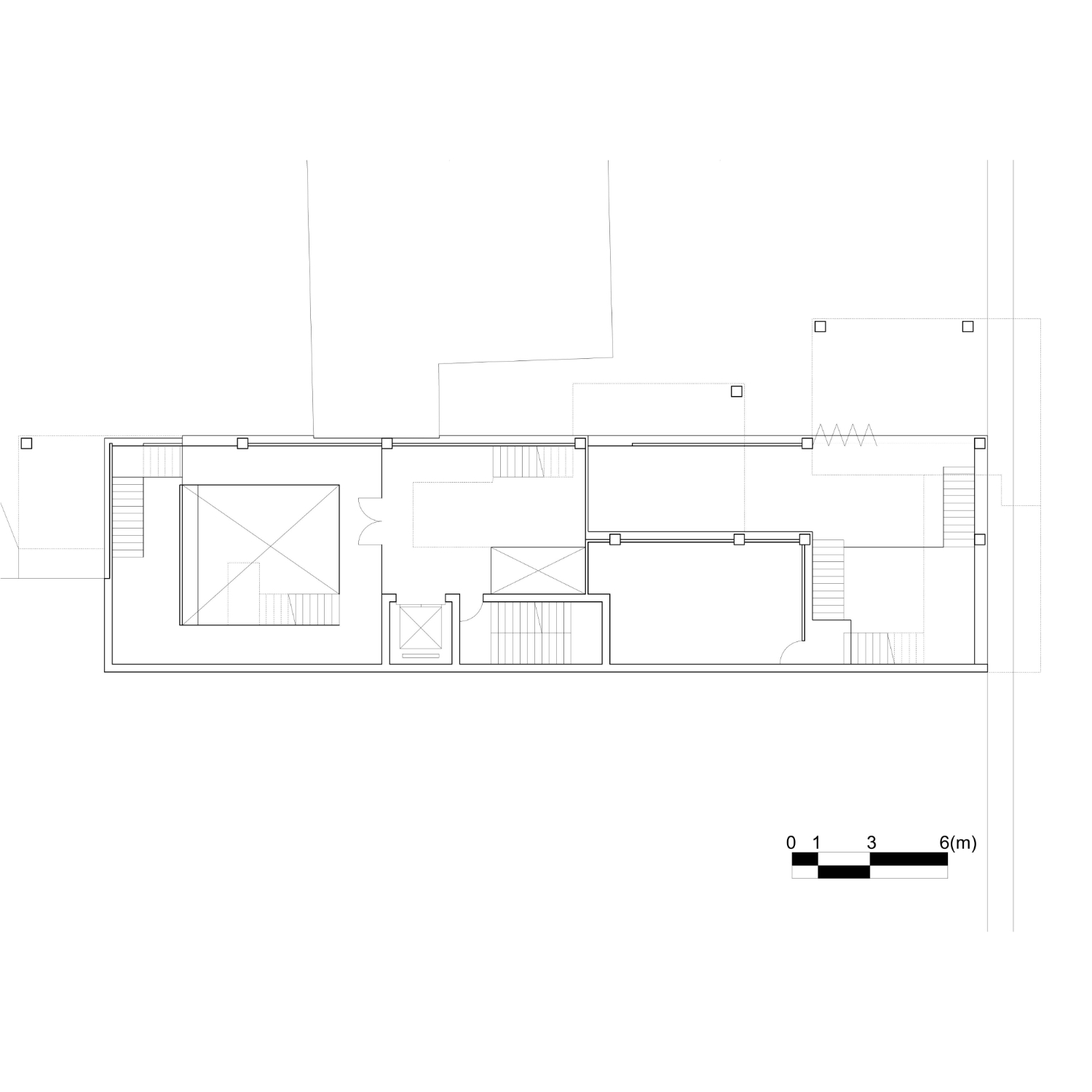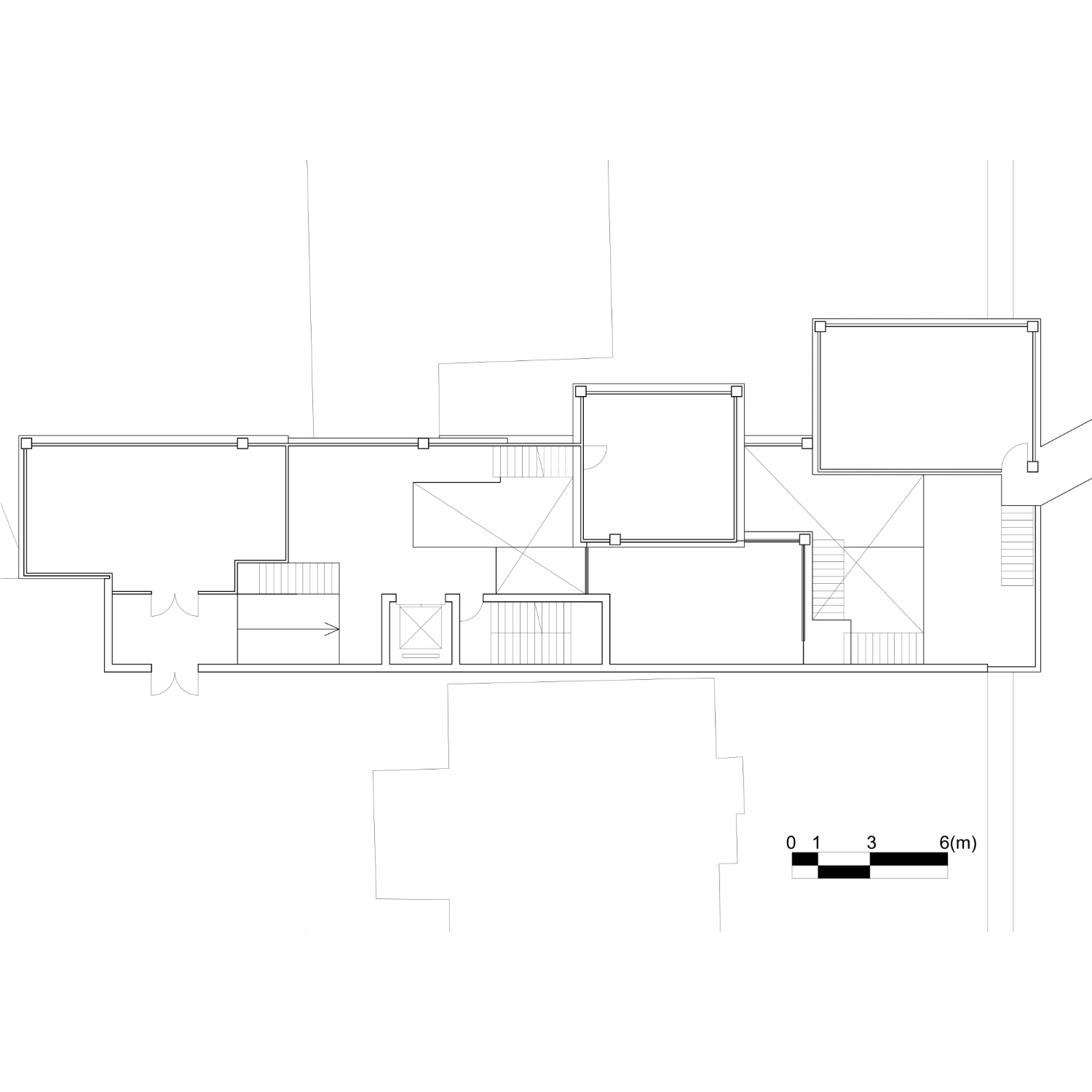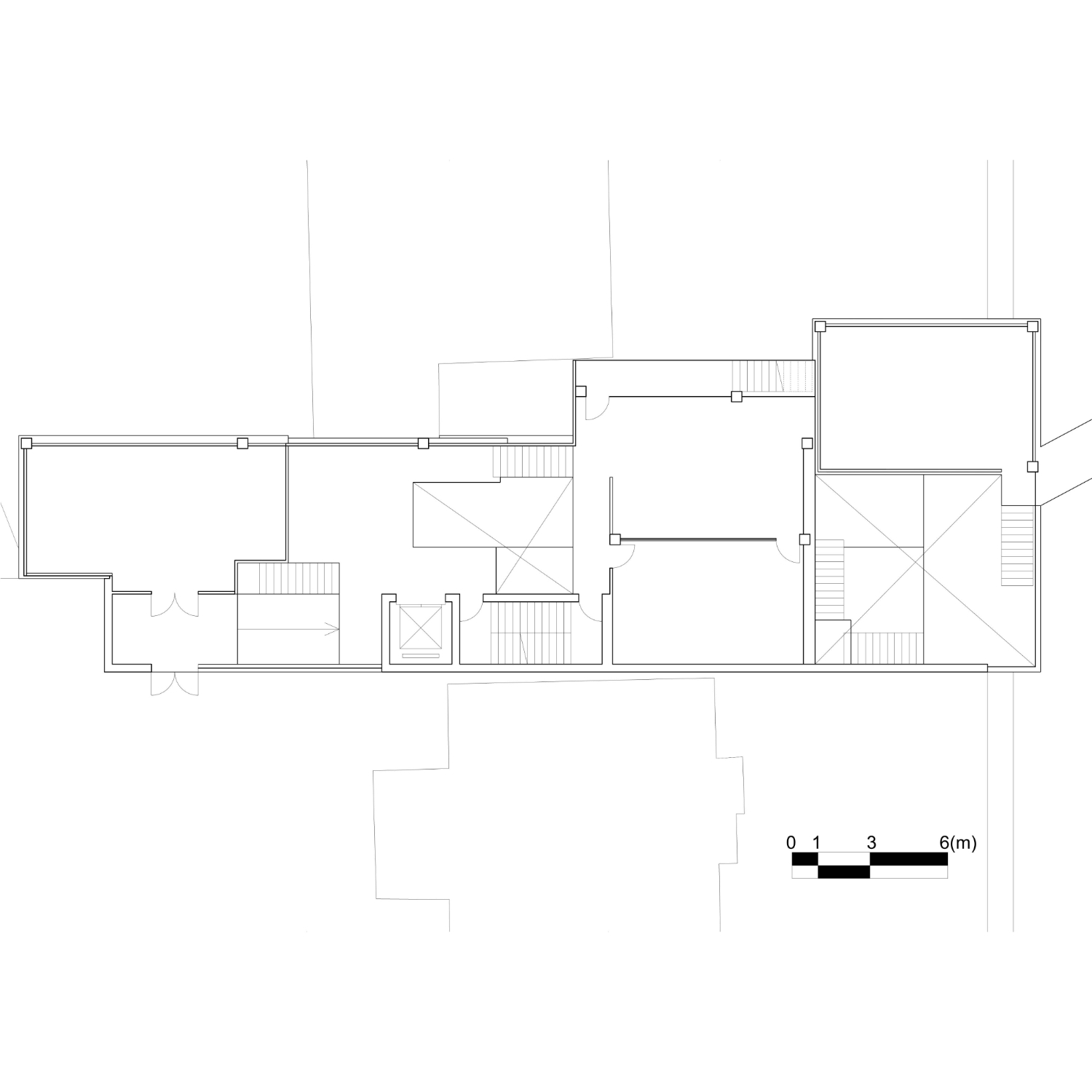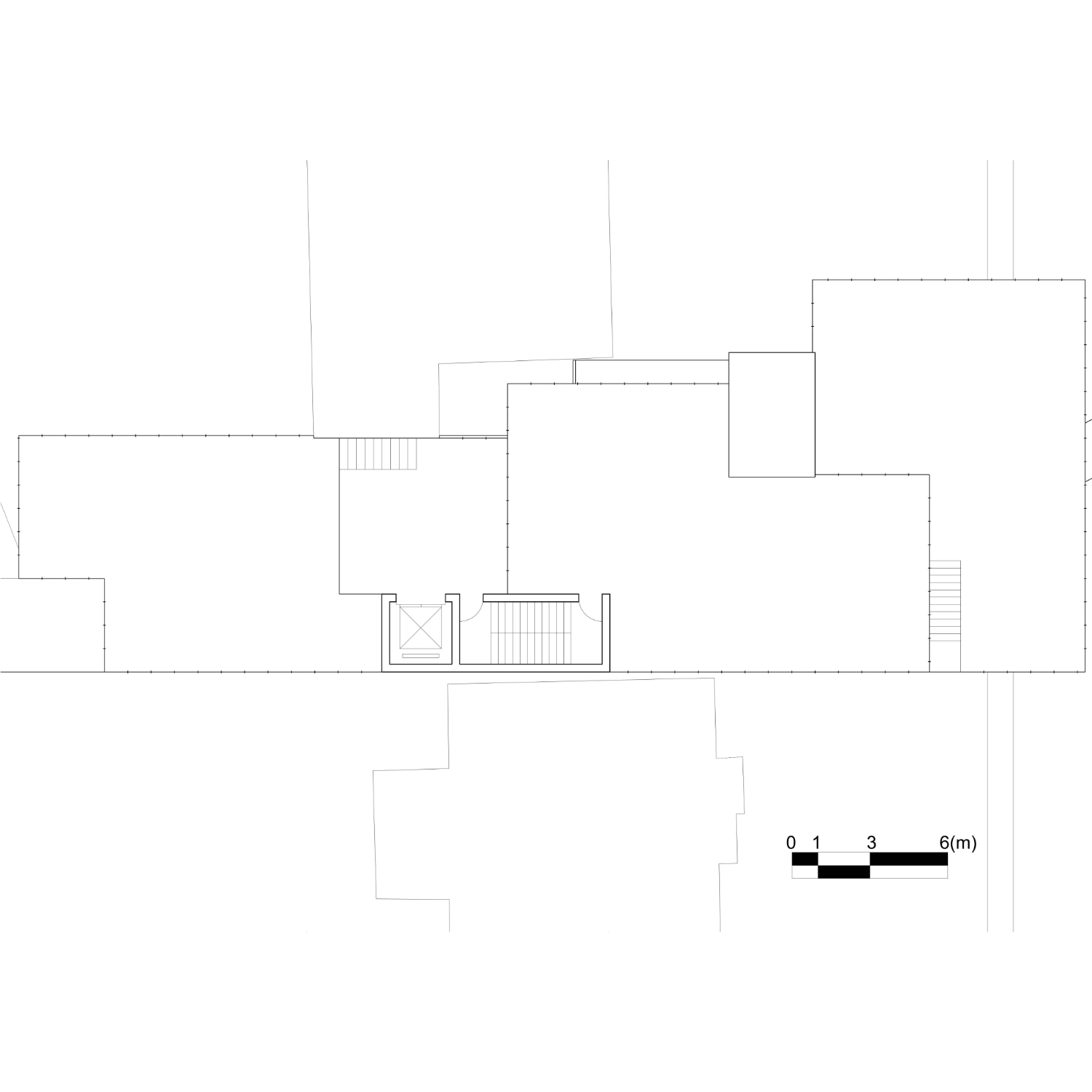홍기헌 _ 판상의 조화
우리나라는 임대주택 제도가 시행되고 있다. 문제는, 물리적으로 분리된 환경과 주택 외관의 차이 등에 따른 분양주택 주민과 임대주택 주민 사이의 차별과 갈등이 존재한다는 사실이다. 최근 외국 사례를 따라 소셜믹스를 시도하고 있는데도 사람들 사이에 이미 자리 잡은 서로에 대한 편견과 불신, 혐오는 인터넷 공간에서 여전히 적나라하게 드러나고 있다. 이것은 현대사회의 개인주의와 맞물려 근본적으로 서로 다른 계층 간 적극적 소통이 일어나지 않기 때문이다.
이에 과거 임대주택과 분양주택의 구별을 뚜렷하게 밝혀 겉으로 차별을 드러냈던 대표 장소를 사이트로 택해, 단절의 원인이 되는 특정 공간을 중심으로 개선하고자 했다. 사례지 '보문파크뷰자이아파트'에는 7m가 넘는 장벽이 임대아파트와 분양아파트를 갈라 놓고 있다. 이 큰 높이차를 해소하는 요소는 좁은 계단뿐이다. 일면식이 없는 사람끼리 만나 대화하고 서로 일상을 공유하기에는 너무 좁고, 짧고, 삭막하다. 그래서 두 동을 잇는 사이 공간인 계단은, 고지대와 저지대 사이를 이동할 때만 사용될 뿐, 특별한 활동이 일어나지 않는 유휴공간으로 남아 있다. 이런 계단은 연결은커녕 서로 간의 불신과 편견을 강화할 뿐이다.
이에 본 설계안은 이 좁은 계단을 넓혀보자는 아이디어로부터 시작한다. 좁았던 계단이 넓어지면 그곳에서 활동이 일어날 수 있기 때문이다. 계단을 수평으로 확장하면 여러 다른 레벨의 판이 만들어진다. 하지만 계단과 같은 모양의 판은 서로 다른 판의 모습을 볼 수 없다. 판을 이리저리 움직이고 파내면서 서로를 볼 수 있게 하고, 높이를 조절해 서로 이동하게 쉽게 했다. 이 때 판의 배치와 평면구성을 자유롭게 하기 위해 flat-plate 구조를 적용했다. 이렇게 되면 서로의 일상에 접하며 교류의 싹을 틔울 수 있는 물리적 조건이 마련된다.
흰색의 판은 기존에 있던 수직의 장벽과 대비되어 그 수평성을 강조하지만, 건물의 벽은 장벽과 동일한 검은색 석재 마감으로 통일함으로써 장벽과 연장되는 느낌을 준다. 그러나 그것은 단절의 연결이 아니라, 장벽의 연결의 상징과 결합하여 기능할 수 있음을 보여주며, 또한 흰색의 판이 주변 컨텍스트와 충돌하지 않고 자연스럽게 스며들도록 하는 요소가 된다. 둘 중 어디에도 속하지 않는 기둥은 단절된 이웃의 합일에 대한 희망을 위해 밝으면서도 너무 차분하지 않고 발랄한 느낌의 포인트 컬러로 연노랑색으로 마감했다.
프로젝트의 전체적인 구성은 크게 두 phase로 나뉘는데, phase 1이 '계단의 확장'이라면 phase 2는 '확장의 확장'이다. 확장으로부터 일어나는 긍정적인 효과를 인접해 있는 다른 공간으로 확장하는 가능성을 모색하는 것이다. 아파트 단지의 건너편, 경사의 아랫길에는 낙후지역의 오래된 건물들이 펼쳐져 있다. 판이 임대주택과 분양주택을 잇는 것에 그치지 않고 그쪽으로 퍼져나간다면 더욱 넓은 폭의 소득계층과 주민들의 소통의 장이 생기는 것이고, 보문역까지 이어진다면 출퇴근길에 들르는 공간이라는 성격도 부여되므로 더 강력한 유입의 동기가 되고, 나아가 지역 전체의 활성화도 노릴 수 있을 것이다.
결론적으로 본 프로젝트는 특정한 형태에 한정된 것이 아니라, 서로 다른 성격과 공간과 집단을 수평적으로 연결하는 하나의 가능성을 보여주는 것이라 할 수 있겠다.
Korea operates public rental housing system. The issue, however, is that discrimination and tension persist between residents of rental and owner-occupied housing, largely due to physical separation and noticeable differences in building appearance. Despite recent attempts to promote social mixing—drawing from international examples—deep-rooted prejudice, distrust, and even hostility between groups continue to surface openly in online spaces. This problem is exacerbated by modern individualism, which further limits active communication between social classes.
In response, this project selects a site that once clearly exposed the divide between rental and ownership housing—a place where spatial design made this discrimination visibly apparent. Bomun Park View Ja-i Apartments, is a prime example: a wall over seven meters tall splits the rental and owner-occupied buildings. The only connection between them is a narrow stairway. It is too cramped, short, and uninviting for unfamiliar neighbors to meet, talk, or share their daily lives. As a result, this in-between space remains a sterile passage, used only to move between the upper and lower areas—an idle void with no meaningful activity. Instead of fostering connection, it reinforces prejudice and mistrust.
This design proposal began with a simple idea: what if we made that staircase wider? Once expanded, the space could become active. Horizontally stretching the stair creates multiple plates on varying levels. However, if these plates just mimic the rigid form of stairs, they obscure each other. So by carving and shifting them, I tried to allow for visibility between layers and smoother transitions in elevation. To achieve greater freedom in layout and plate positioning, flat-plate structural system was adopted. This configuration lays the physical groundwork for spontaneous encounters and shared daily moments, encouraging natural interaction.
The white plates visually contrast the existing vertical wall, highlighting their horizontality. Meanwhile, the surrounding walls adopt the same dark stone finish as the dividing wall, creating a sense of visual continuity. But rather than reinforcing separation, this continuity reinterprets the wall as a symbolic extension—not of division, but of potential connection, allowing the white plates to blend gently into the surrounding context. The columns, which do not belong to either side, have color of soft yet cheerful pale yellow— which symbolizes hope for unity between once-separated neighbors.
The project unfolds in two major phases. Phase 1 is the “Expansion of the Stair,” and Phase 2 is the “Expansion of the Expansion.” In other words, it explores how the positive effects of the initial intervention might spread to adjacent areas. Across the street, down the slope, lies a neglected neighborhood with older buildings. If the newly formed plates extend beyond just linking rental and owner-occupied housing—reaching into that area—they could become a platform for broader communication among a more diverse range of income groups. If extended toward Bomun Station, the space could also function as a stop along daily commuting routes, providing a stronger incentive for use and potentially driving revitalization throughout the area.
In conclusion, this project is not limited to a specific architectural form. Rather, it presents a spatial possibility—one that horizontally connects contrasting functions, spaces, and communities in a way that challenges the norms of urban division and encourages shared experience.
